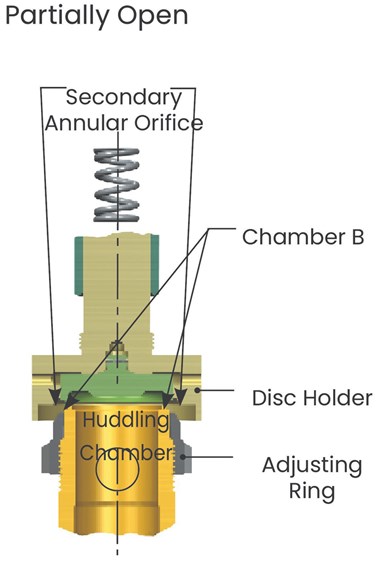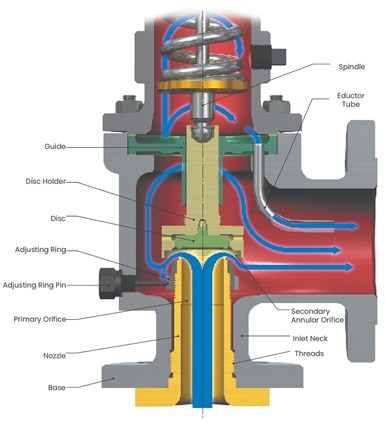Pressure Relief Valve Basics – Spring-Loaded Safety Relief Valves
Learn for the first time or brush up on this common valve product.
#pressure-relief #basics #knowyourvalves
Pressure relief valves have been around for hundreds of years and continue to play a very important role as the last line of defense for the protection of life and property in the event of an overpressure event.
Depending on your expertise level, this article could be a great starting point to learn everything about the basics of pressure relief valves or this could be a refresher for those who like to double-check and compare notes. This article will be the first in a series of three articles where we will introduce three types of pressure relief valves. In this first article, we will cover the operational basics of a spring-loaded safety relief valve. In future articles, our second installment will cover the operation of a pilot-operated safety relief valve and a third installment will cover the operation of safety valves.
Pressure relief valve (PRV) is a term used to describe a category of valves designed for use in overpressure protection applications. You may have heard a lot of different terms for PRVs: safety valve (SV), relief valve (RV), safety relief valve (SRV) or pilot-operated safety relief valve (POSRV). They all operate similarly but are not exactly the same, depending on who you talk to and the level of pressure relief valve knowledge one has. Like any other type of equipment, whenever you look from the outside in, everything seems to be the same. If you start to dig a little bit deeper into the details, you will discover the differences. So, let’s get right to it and get into the details. First, we will cover some terms and definitions and then we will get into the details of how a spring-loaded safety relief valve operates.
Pressure relief valve (PRV) — a device designed to open and relieve excess pressure, then close and prevent the further flow of fluid after normal conditions have been restored.
Relief valve (RV) — a spring-loaded pressure relief valve actuated by the static pressure upstream of the valve. A relief valve is used primarily with incompressible fluids.
Safety Relief Valve (SRV) — a spring-loaded pressure relief valve that may be used as either a safety or relief valve, depending on the application.
Pilot-Operated Safety Relief Valve (POSRV) — a pressure relief valve in which the major relieving device or main valve is combined with and controlled by a self-actuating auxiliary pressure relief valve called a pilot valve.
Safety Valve (SV) — a spring-loaded pressure relief valve actuated by the static pressure upstream of the valve and characterized by rapid opening or pop action. A safety valve is normally used on compressible fluids, primarily steam.
Now, let’s get into this article’s topic, which is the operational basics of a spring-loaded safety relief valve (SRV).
A spring-loaded SRV consists of an inlet nozzle that is connected to a vessel or system to be protected, a disc that moves to control the flow through the nozzle and a spring that controls when the valve opens and the position of the disc. The valve operates by using inlet system pressure to overcome a spring load and, as a result, the valve opens to relieve a defined capacity. When the valve is closed, as shown in Figure 1, the spring force resists the upstream pressure acting against the seating surfaces (Area A). As the pressure increases, the pressure at (A) tends to equalize the spring force and the pressure holding the seats together approaches zero.

Figure 1: SRV closed position
Photo Credit: All images courtesy of Baker Hughes
When the upstream pressure increases to within one to two percent of the valve’s set pressure, media will move past the seating surfaces into Chamber B, as shown in Figure 2. Flow restriction in the secondary annular orifice causes pressure to build up and to act over a larger area, creating an additional force to overcome the spring force. The disc will then move away from the nozzle seat and the valve will “pop” open.

Figure 2: SRV partially open
Once the valve has opened, an additional pressure build-up occurs at (C) as shown in Figure 3. This is due to the sudden flow increase and the restriction to flow through another annular orifice formed between the inner edge of the disc holder and the outside diameter of the adjusting ring. These additional forces at (C) cause the disc to lift substantially at “pop.” Flow is restricted by the opening between the nozzle seat and disc seat until the disc seat has been lifted from the nozzle seat by approximately one-quarter of the nozzle-throat diameter. After the disc has attained this degree of lift, flow is restricted by the primary orifice rather than by the area between the seating surfaces. Blowdown (the difference between opening and closing pressure) can be controlled within limits by positioning the single adjusting ring. Blowdown is caused when the spring force is unable to overcome the summation of the forces at (A), (B), and (C) until the pressure at (A) drops below the set pressure.

Figure 3: SRV fully open
Below, in Figure 4, is an illustration of the fluid flow through the valve. It is significant to recognize that the system pressure enters through the nozzle and remains at a high pressure until it expands through the secondary annular orifice. Pressure downstream of the secondary annular orifice is much lower than the system pressure.

Figure 4: Flowpath through PRV
Features
Adjusting Ring
The adjusting ring in a safety relief valve is set to predetermined positions before the valve is put into service. Presetting makes it less necessary to pop the valve in service to ascertain that the ring has been set properly to achieve the necessary lift and relieving capacity.
Simple Blowdown Adjustment
A single adjusting ring adjusts blowdown, or reseating pressure, in a safety relief valve. When the ring is moved upward, blowdown is increased (lowering the reseating pressure), and when it is moved downward, the blowdown is decreased (raising the reseating pressure). In comparison, when valves have two or more adjusting rings, each affects valve action as well as blowdown.
Common Industries and Applications
Spring-loaded SRVs can be found in many industries. Some common industries include power generation, refining, petrochemical, chemical, midstream oil and gas, upstream oil and gas, and pulp and paper. Some common applications for spring-loaded SRVs include distillation, hydroprocessing, reforming, cracking, blending, fractioning, charge gas compression, separation, compression, pipeline integrity, dehydration and balance of plant applications for gases, liquid and two-phase application media.
The operation of a spring-loaded SRV is basic in principle with just a few elements which control their function. There is plenty more that can be discussed about SRVs, such as trim types, how they operate and when to use specific trim but for now, we will just stick to the basic SRV operation principles. Look for future articles on the operation of pilot-operated safety relief valves and safety valves.

Wai Loon Cheong is the valves training leader for Baker Hughes. He has more than 20 years experience, and has worked in a variety of roles at the company.
RELATED CONTENT
-
Understanding Torque for Quarter-Turn Valves
Valve manufacturers publish torques for their products so that actuation and mounting hardware can be properly selected.
-
Ball Valve Basics
Welcome to the first in a series of Valve Basics articles, each focused on a major product type and written especially for newcomers to the industries that use and make valves and related products.
-
Air Valves in Piping Systems
Liquid piping systems are prone to collecting air from incoming fluids, pumps and connections.







 Unloading large gate valve.jpg;maxWidth=214)

